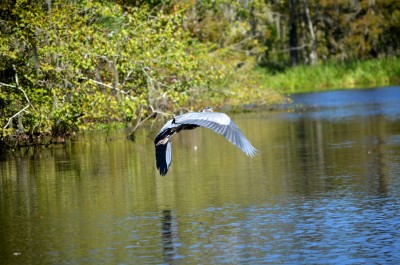Maurepas Swamp, Part 2
Swamp Things:
The Wild Side of Maurepas Swamp
Written by Wendy Billiot for Louisiana Wildlife Federation
The early morning sun rays streak through the wispy Spanish moss, casting long shimmers of light across the surface of the water. A prothonotary warbler sings high in the bald cypress while the great blue heron flaps to a graceful landing on a nearby log in search of breakfast. A red-eared turtle plops into the water at the sound of our approach, while an alligator suns undisturbed on a submerged log. In the distance, a majestic bald eagle calls to its mate as they visit their giant nest atop one of the many ethereal cypress trees, where they return every fall to hatch another brood of offspring. An osprey flies over, its talons clinging to a flopping fish. Bullfrogs bellow intermittently from deep within the swamp. Cicadas sing their songs high among the tupelo, while a largemouth bass breaks the surface with a splash.
These are the sights and sounds of the Maurepas Swamp—a 140,000-acre wetland habitat whose future hangs precariously in the balance of sustainability as tidal saltwater, subsidence, and low oxygen levels threaten this unique and valuable ecosystem. Despite its threatened condition, the swamp continues to provide vital habitat for animals, birds, and fish.
Located within the Mississippi flyway, the Maurepas Swamp provides a veritable “rest area” for transient songbirds such as species of warbler, cuckoos, vireos, and woodpeckers as they make their way north and south each year. More than 325 bird species make the round-trip each year from their breeding grounds in Canada and the northern United States to their wintering grounds along the Gulf of Mexico and in Central and South America. Widgeon, mottled, and redhead ducks are among the migratory waterfowl that enjoy wintering in the swamp.
However, the Maurepas Swamp has experienced severe degradation since the 1930s and the leveeing of the Mississippi River, which can no longer naturally replenish the swamp with the much-needed fresh water and sediment from its source. Just as humans and wildlife historically depended on the swamp with its life-sustaining resources, the swamp must now depend on man and the Mississippi River for its life-sustaining resources. The river’s supports include fresh water and fine sediments, without which the Maurepas will continue to degrade: bald cypress and tupelo will die, fresh water slowly turns brackish. Eventually the entire ecosystem becomes totally off balance, hanging on the precipice of complete destruction.
Fortunately, in its current state, the Maurepas Swamp is not past the point of no return, and contained within the 2017 Louisiana Master Plan for a Sustainable Coast is a viable solution to save and restore this valuable swamp–the Mississippi River Reintroduction into the Maurepas Swamp Project. By diverting fresh water and fine sediments from the Mississippi River into the swamp, life-giving and life-sustaining elements will be channeled into the swamp helping to refresh and restore roughly 45,000 acres of forested wetlands. This manmade means of replicating what the mighty Mississippi once did for the swamp is a necessary step toward restoring and preserving this magnificent and diverse wetland environment for future generations. If we do nothing, then we all lose—wildlife, birds, fish, and humans alike, and the Maurepas Swamp is well worth saving.







I keep hoping that someday, I’ll get to come back thru some of the wetlands/swamps in LA. I remember seeing some of them as my aunt and uncle drove thru them on our way to a revival in the southern part of Mississippi. To a child, with the sun setting, they were mysterious, dark, dangerous and filled with hidden treasures. It has been over 50 years and reading your article brought those memories back. Thank you.
It would be so nice if you could visit again, but I fear things have changed drastically in 50 years . . . a lot less beauty to behold where swamps are concerned, due to saltwater intrusion and other causes. But glad the piece brought those memories back for you. Happy New Year, Cam!
Your stories are always a breath of fresh air. I hope you and your family and your surroundings have a wonderful New Year.
Keep us up to date on what’s going on.
Hugs
Jeri Petersen
Happy New Year, Jeri! I’m pleased you enjoyed this piece. It’s just more formal than my freestyle blog pieces! Since this swamp is a two-hour drive from me, I probably won’t be kept in the loop of this project, which may take five more years to complete, so I can’t really keep us in the loop, so to speak. Many changes coming for my bayou community, too, which I will touch on later in the year. Thanks for being here!
They have known about it’s slow death for years. Now they need to get their heads out of their paperwork (bet you thought I was going to type something else) and DO something! I don’t know about you, but I get tired of hearing about doing “studies“ or forming a committee of politicians to stick their noses into something they know absolutely nothing about. They just THROW resources for study after study. The Swamp is beautiful and I hope something is done to preserve it.
Ok my rant is over for 2017!
Happy New Year, Wendy!
You’re preaching to the choir, sister, as I live and breathe it every day. This swamp, in a round about way, also protects your home! Keep in mind that those who study continue to have a job as long as those studies continue, no matter how fruitless and futile they are! This project will take place, and hopefully, it will help restore it to a healthier status. Warning: There’s one more piece in this series of three yet to be published. I’ll share when the time comes. Happy New Year, Steffi!